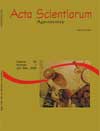<b>Population arrangement for corn cultivation in central region of Mato Grosso do Sul state</b> - DOI: 10.4025/actasciagron.v26i1.1957
Abstract
The equidistant space arrangement of plants in a productive system is fundamental once it is one of the essential factors for the plant to explore the available resources and display all its production potential. The space arrangement of the plants in the area is achieved by means of interaction of the spacing among lines and plants on the line, resulting in the ideal population per area unit for each cultivar and / or hybrid. However in most work performed it is noticed a variation in the spacing among lines only keeping fixed the sparing among plants in the line or vice-versa. The present study aims to define population arrangements for corn cultivation in Mato Grosso do Sul State. The experiment was conducted in the agricultural year 2001/2002, at Idaterra experimental land located in Campo Grande - MS. The soil was latossolo dark red. The treatments were all obtained by the interaction of 40cm, 50cm, 60cm, 70cm and 80cm spacing among lines with the following population densities: 50.000, 62.500, 75.000 and 87.500 corn plants per hectare. The experimental delineation used was casual blocks, divided parts and the sub-parts by population densities. The corn culture used was AG 9010, super precocious cycle, simple hybrid, short size and semi-erect leaves. There was no significant interaction between spacing and population density. In relation to the characteristics forming the return components of grains in corn cultivation, it did not have significant effect for the espaçamento between lines. However, in the variation of the population density, it occurred. The was a significant rise in the number of NE/ha as the population of plants/ha rose. The opposite happened for NFE, NGF and RGE, where the bigger the population densities, the smaller the profit components. The results for grain return indicated that bigger and heavier corncobs are not directly related to higher productionDownloads
Download data is not yet available.
Published
2008-04-11
How to Cite
Scheeren, B. R., Bazoni, R., Bono, J. A., Arias, S. S., Oliveira, R., & Salomão, L. (2008). <b>Population arrangement for corn cultivation in central region of Mato Grosso do Sul state</b> - DOI: 10.4025/actasciagron.v26i1.1957. Acta Scientiarum. Agronomy, 26(1), 55-60. https://doi.org/10.4025/actasciagron.v26i1.1957
Issue
Section
Agronomy
DECLARATION OF ORIGINALITY AND COPYRIGHTS
I Declare that current article is original and has not been submitted for publication, in part or in whole, to any other national or international journal.
The copyrights belong exclusively to the authors. Published content is licensed under Creative Commons Attribution 4.0 (CC BY 4.0) guidelines, which allows sharing (copy and distribution of the material in any medium or format) and adaptation (remix, transform, and build upon the material) for any purpose, even commercially, under the terms of attribution.
2.0
2019CiteScore
60th percentile
Powered by 

2.0
2019CiteScore
60th percentile
Powered by 



















































